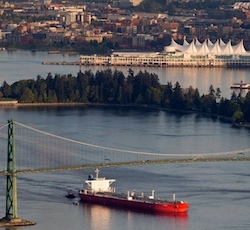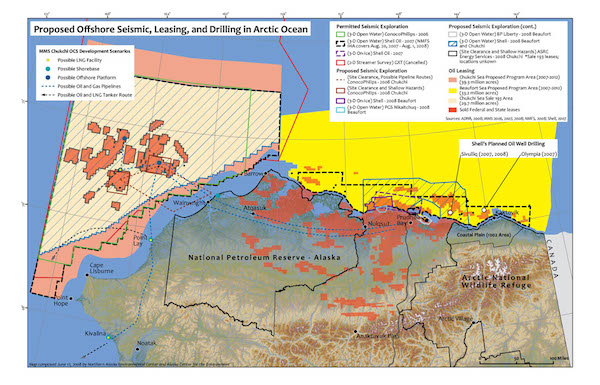Dec 30 2016
British Columbia has been a hotspot of concern—and research—about the extent and the impacts of shipping noise. The southern BC coast is close to acoustic saturation, with any increase in noise having the potential to completely overwhelm the underwater soundscape; meanwhile the northern coast holds a few areas that are still nearly free of human noise intrusion, and we need to do all we can to preserve these increasingly rare acoustic refuges. These contentious waters have been roiled in several contradictory though perhaps ultimately productive ways by recent Canadian government actions. In the month between Thanksgiving and Christmas, a northern pipeline was rejected and a southern one approved; meanwhile, ongoing research aims to identify the noisiest ships and help inform new regulations that could reduce overall noise levels.
 The biggest headlines and fears have been spurred by the final approval of the Trans Mountain Pipeline expansion that will deliver oil from the Alberta tar sands to an existing port in Burnaby, BC. The port currently hosts about five tankers a month; the increased flow in the expanded pipeline (75% the capacity as the proposed Keystone XL) will necessitate about 35 ships a month, meaning an average of two tanker transits a day past Vancouver as they travel to and from the Strait of Georgia off the coast. These waters are currently burdened by shipping noise 85% of the time, and the increased traffic will push this to 100% in some areas. Concern centers on the tenuous status of the region’s orca populations, which are struggling to find the salmon they need; shipping noise makes it harder for them to track salmon with their echolocation clicks and to communicate with each other as they search for food. “Death by a thousand cuts, and this is a very deep cut,” says Deborah Giles, research director for the Center for Whale Research. “They’re spending more energy to find less food and we’re adding the equivalent of a rock concert,” she says. “These whales will not survive.”
The biggest headlines and fears have been spurred by the final approval of the Trans Mountain Pipeline expansion that will deliver oil from the Alberta tar sands to an existing port in Burnaby, BC. The port currently hosts about five tankers a month; the increased flow in the expanded pipeline (75% the capacity as the proposed Keystone XL) will necessitate about 35 ships a month, meaning an average of two tanker transits a day past Vancouver as they travel to and from the Strait of Georgia off the coast. These waters are currently burdened by shipping noise 85% of the time, and the increased traffic will push this to 100% in some areas. Concern centers on the tenuous status of the region’s orca populations, which are struggling to find the salmon they need; shipping noise makes it harder for them to track salmon with their echolocation clicks and to communicate with each other as they search for food. “Death by a thousand cuts, and this is a very deep cut,” says Deborah Giles, research director for the Center for Whale Research. “They’re spending more energy to find less food and we’re adding the equivalent of a rock concert,” she says. “These whales will not survive.”
Environmental groups will likely file suit challenging the approval, citing the government’s failure to mitigate the increased impact. At the same time, though, Fisheries Minister Dominic LeBlanc and Transport Minister Marc Garneau are working on a revamped recovery plan for the 80 remaining resident orcas. LeBlanc notes that Read the rest of this entry »
Jul 14 2015
Shell Oil is gearing up to do the first new exploratory drilling in the Chukchi Sea off northwestern Alaska. The project has been in the pipeline for years, and has faced numerous legal challenges (mostly regarding the danger of a spill and climate imperatives) and logistical snafus (the most extreme being a drill ship that ran aground). Just last month, a consortium of environmental groups filed a suit challenging the most recent permits; there has yet to be a ruling. The expansion of oil and gas development from Alaska’s north slope to offshore waters will create a marked increase in human noise in an ocean region that is currently relatively free of our intrusions. Exploration leases have been sold in both the Chukchi Sea (left below) and Beaufort Sea (right below).

Earlier this year, the Obama administration officially put some areas in these waters off limits, but a close inspection of the maps presented then reveal that virtually none of these areas were planned for development when the above map was created in 2008; the exclusion zones appear to match the near-shore areas excluded above (one exception: a small portion of the Chukchi zone is now off-limits).
Noise concerns extend far beyond the drilling itself, or even the seismic surveys that take place prior to drilling and during the life of the project. The drill rigs come along with a support fleet of 30 other boats and several aircraft, promising a steady din in the area. “In the Arctic, I can’t emphasize how novel an activity this is,” says NRDC attorney Giulia Good Stefani. “It really is a whole new level of disturbance for an area already experiencing rapid change and stress.” Concerns extend from whales to walruses, seals, and polar bears.
A wide array of ongoing research is underway, aiming to characterize the current soundscape in arctic waters. Read the rest of this entry »
Apr 07 2011
Two new studies on seismic survey impacts have been released by the Joint Industry Program (JIP) Sound and Marine Life research program, funded by oil and gas companies.
The first looked at the effectiveness of “soft start” ramp up of seismic survey airguns at night and at times of poor visibility. This has become standard procedure, but there have been some concerns that if marine mammals were very close to the ship, even the low sound levels at the start of the ramp up could be loud enough to cause hearing damage. Based on two different modeling approaches, the study found “no instances…in which the threshold levels for hearing injury for cetaceans were reached during the initial stages of the soft-start sequence. This suggests that the animals are not at significantly greater risk of harm when a soft start is initiated in low visibility conditions.” Link to pdf of report at the website of the International Association of OIl and Gas Producers.
The second study aimed to address “the rarely-charted relationship between oil Exploration and Production (E&P) activities and trends in cetacean stocks.” The study cites case studies involving populations of sperm whales in the Gulf of Mexico, humpback whales, blue whales and fin whales off the coast of California, northern bottlenose whales off Nova Scotia and harbour porpoises and minke whales off the east coast of the UK. The study, published in Aquatic Mammals, provided new insights into the worldwide distribution of E&P activity in relation to marine mammal populations and has also revealed striking data gaps in our understanding of cetacean population numbers and trends. While the report’s review of seven stocks “found signs of an increase in numbers in one population (Californian humpback whales),” for the remaining six, “population trends could not be assessed due to the high variability in the abundance estimates.” Link to pdf of this report.
In essence, there is not enough data to really tell us whether ongoing oil and gas activity has reduced stocks over the long term. As usual in the many cases where ocean noise and population studies come up against this paucity of solid data, the researchers recommend that someone should fund of future studies ‘that provide more comprehensive data on cetacean stocks.”
JIP research page
Main JIP website
OGP publications page
OGP main page
May 08 2008
A surge in lease sales along Alaska’s west and north coasts has spurred predictable resistance from locals and environmental groups. While the effect of any possible oil spills in harsh waters is certainly a major focus of concerns being voiced, the impacts of the first phase of oil and gas exploration have moved to the forefront of discussions. The oil industry is gearing up to explore a record number of offshore lease areas in the next few years, and this summer, up to five seismic survey vessels are scheduled to be off the Alaskan coast, firing airguns 2-4 times per minute and listening for the echoes Read the rest of this entry »
Apr 12 2008
Bristol Bay Oil and Gas Planning Announced by MMS; CBD Vows to Stop Leasing Process Due to Critical Habitat Designation – The Minerals Management Service has officially announced the start of a planning process to consider a 2011 lease sale for offshore oil and gas exploration in the North Aleutian Basin in Alaska. The publication of the proposal marks the start of the process, which will involve a public comment period and months of gathering information for an environmental impact statement, said Robin Cacy, a minerals service spokeswoman in Anchorage. “No decisions have been made on the sale. This is just the beginning,” she said. The area, which had been protected from drilling since 1990, is north of the Aleutian Islands near Bristol Bay. On the same day that the plan was announced, NMFS published its final decision naming parts of the lease sale as Critical Habitat for the North Pacific right whale. Read the rest of this entry »
 The biggest headlines and fears have been spurred by the final approval of the Trans Mountain Pipeline expansion that will deliver oil from the Alberta tar sands to an existing port in Burnaby, BC. The port currently hosts about five tankers a month; the increased flow in the expanded pipeline (75% the capacity as the proposed Keystone XL) will necessitate about 35 ships a month, meaning an average of two tanker transits a day past Vancouver as they travel to and from the Strait of Georgia off the coast. These waters are currently burdened by shipping noise 85% of the time, and the increased traffic will push this to 100% in some areas. Concern centers on the tenuous status of the region’s orca populations, which are struggling to find the salmon they need; shipping noise makes it harder for them to track salmon with their echolocation clicks and to communicate with each other as they search for food. “Death by a thousand cuts, and this is a very deep cut,” says Deborah Giles, research director for the Center for Whale Research. “They’re spending more energy to find less food and we’re adding the equivalent of a rock concert,” she says. “These whales will not survive.”
The biggest headlines and fears have been spurred by the final approval of the Trans Mountain Pipeline expansion that will deliver oil from the Alberta tar sands to an existing port in Burnaby, BC. The port currently hosts about five tankers a month; the increased flow in the expanded pipeline (75% the capacity as the proposed Keystone XL) will necessitate about 35 ships a month, meaning an average of two tanker transits a day past Vancouver as they travel to and from the Strait of Georgia off the coast. These waters are currently burdened by shipping noise 85% of the time, and the increased traffic will push this to 100% in some areas. Concern centers on the tenuous status of the region’s orca populations, which are struggling to find the salmon they need; shipping noise makes it harder for them to track salmon with their echolocation clicks and to communicate with each other as they search for food. “Death by a thousand cuts, and this is a very deep cut,” says Deborah Giles, research director for the Center for Whale Research. “They’re spending more energy to find less food and we’re adding the equivalent of a rock concert,” she says. “These whales will not survive.”
